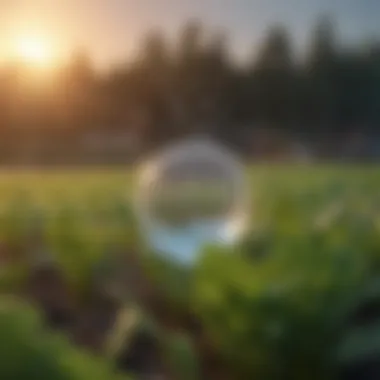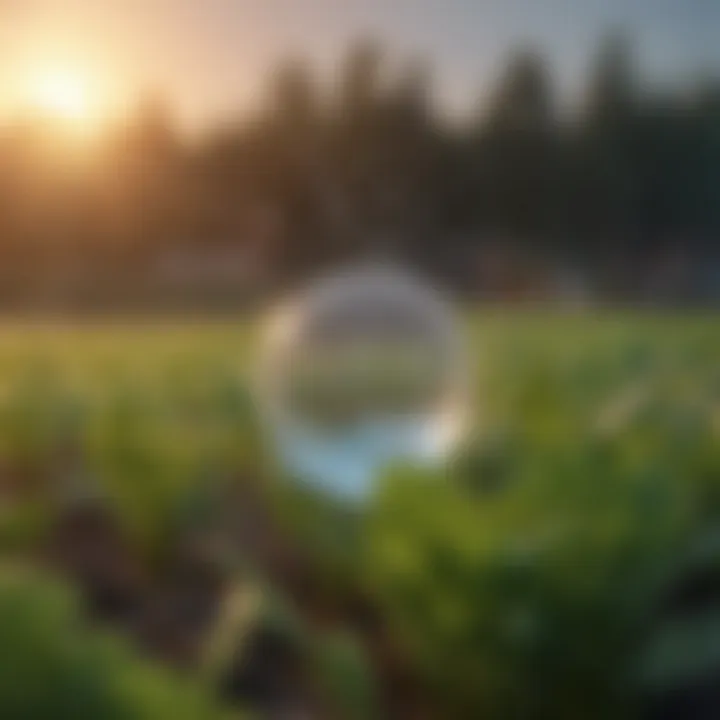Nanobubble Aeration: Transforming Water and Agriculture


Intro
Nanobubble aeration emerges as a cutting-edge approach to address challenges in water treatment and agriculture. As freshwater resources face increasing pressure from various human activities, the need for efficient and sustainable water management practices becomes even more urgent. Nanobubbles, characterized by their small size, high stability, and unique physical properties, offer innovative solutions in this context. The discussion that follows will unravel the core principles, technological advancements, and practical applications of nanobubble aeration in detail.
Key Concepts and Terminology
Basic Definitions
Nanobubbles are tiny gas bubbles with a diameter of less than 200 nanometers. They are distinct from regular bubbles due to their impressively high stability and low buoyancy. The formation of these nanobubbles leads to a large surface-area-to-volume ratio, providing enhanced interaction with liquids and solids in their environment. This unique property allows for improved oxygen transfer and increased dissolution rates in water.
Historical Context
The concept of using bubbles for various applications is not new. However, the development of nanobubble technology began in the late 20th century. Scientists started to investigate their potential in various fields, including water treatment and agriculture. Early studies focused on the stability of nanobubbles and their ability to influence biological processes. Over time, advancements in equipment and generation methods have propelled nanobubble application to the forefront of both water resource management and agricultural practices.
Recent Innovations and Trends
Technological Advancements
Recent years have witnessed a surge in research and development surrounding nanobubble generation technologies. Various methods, such as ultrasonication and membrane separation, have gained prominence for their efficiency and effectiveness. These advancements have made it possible to produce large quantities of nanobubbles at a relatively low cost.
Sustainable Practices
Incorporating nanobubble aeration into water treatment processes aligns with sustainable practices. These techniques reduce the need for chemical additives and limit harmful byproducts often associated with traditional water treatment methods. Moreover, nanobubbles enhance nutrient delivery in agriculture, promoting healthy plant growth while using fewer resources.
Practical Applications and Techniques
Step-by-step Guides
- Generation of Nanobubbles: Utilize equipment like ultrasonicators or membrane systems to create nanobubbles in water. Ensure that the process maintains a constant temperature and pressure for optimal results.
- Integration into Irrigation Systems: Connect nanobubble generators directly to existing irrigation setups. This allows for continuous aeration and nutrient enhancement for crops.
- Monitoring and Evaluation: Regularly test water quality parameters to measure the effectiveness of nanobubble aeration over time. Adjust practices as necessary based on results.
Case Studies
- A study conducted in California demonstrated the positive impact of nanobubble aeration on strawberry crop yields. Through enhanced oxygen levels in soil moisture, plants showed improved growth and resilience.
- Research in wastewater treatment facilities in Europe has shown that implementing nanobubble technology reduces the time required to dissolve pollutants, thereby increasing treatment efficiency.
Nanobubble aeration represents a transformative tool for both water management and farming, offering a pathway to enhanced efficiency and sustainability in practices.
The End
As we consider the potential of nanobubbles, it is crucial to remain aware of the challenges that may accompany their introduction into existing systems. Ongoing research will further clarify best practices and optimize their applications in diverse contexts. The discussion on nanobubble aeration will continue to evolve, presenting opportunities for innovation across agricultural and environmental sectors.
Prologue to Nanobubble Aeration
Nanobubble aeration is an innovative technology gaining traction in both water treatment and agricultural practices. Understanding this technology is vital because it offers an efficient means to enhance water quality and improve agricultural productivity. The ability of nanobubbles to remain stable in liquids allows for increased dissolved oxygen levels, ultimately benefiting aquatic ecosystems and crops alike.
The applications of nanobubble aeration extend beyond simple oxygenation. For instance, in water treatment, it plays a crucial role in precipitating contaminants by facilitating better mixing and enhancing microbial activity. In agriculture, its use improves plant growth rates and reduces water consumption by providing a more efficient delivery of nutrients.
Exploration into the mechanics of nanobubble formation and their unique properties is essential for professionals in water resource management and agriculture. The technology is not just about theoretical benefits; practical implementations and case studies show significant improvements in various sectors. As such, it is important to grasp the foundational concepts of nanobubbles to truly appreciate their potential impact.
"Understanding the fundamentals of nanobubble aeration is the first step towards harnessing its benefits in real-world applications."
In summary, this section will define nanobubbles and delve into the science behind their formation. By familiarizing oneself with these core concepts, one gains a clear perspective on the broader implications of nanobubble aeration in modern practices.
Defining Nanobubbles
Nanobubbles are minute gas-filled bubbles that typically measure less than 200 nanometers in diameter. Unlike conventional bubbles, which quickly rise to the surface, nanobubbles exhibit unique properties, allowing them to remain suspended in liquids for extended periods. The small size of these bubbles enables a larger surface area-to-volume ratio, promoting increased interactions with surrounding fluid media.
Due to their stability and longevity, nanobubbles can influence a multitude of chemical, physical, and biological processes. This is particularly useful in sectors like agriculture and environmental management, where efficient transfer of oxygen and other gases can significantly enhance productivity and treatment outcomes. Furthermore, the collective behavior of nanobubbles assists in multiplier effects beneficial for wastewater treatment or enhancing soil health.
The Science of Small Bubbles


The formation and behavior of nanobubbles involve intricate physical principles. When water is subjected to high shear forces, like those found in aeration devices, gas is introduced and dispersed into very fine bubbles. The resulting small gas pockets are stabilized due to the formation of a thin liquid film surrounding each bubble.
One of the critical aspects of the science behind nanobubbles is their ability to maintain stability. Factors such as surface charge, viscosity, and temperature can all affect their longevity. Researching the behavior of these bubbles provides insights into how they can be manipulated for various applications. The unique characteristics make them suitable for fostering increased biological activity in soil and aquatic environments.
Evaluating the physics behind nanobubbles lays the groundwork for discussion on their generation techniques, stability concerns, and eventual applications in water treatment and agriculture. This understanding is crucial when considering how nanobubble aeration can transform practices in these fields.
Mechanics of Nanobubble Formation
Understanding the mechanics of nanobubble formation is critical to appreciating the transformative potential of nanobubble aeration. This process involves various generation techniques and the unique physical characteristics of nanobubbles, which distinguish them from larger bubbles. By delving into these aspects, we can better understand how nanobubbles can effectively enhance water treatment processes and agricultural practices.
Generation Techniques
The generation of nanobubbles can occur through several techniques, each offering distinct advantages and applications. Common methods include:
- Ultrasound Generation: This technique utilizes high-frequency sound waves to produce tiny bubbles. The rapid oscillation of sound waves generates substantial energy, leading to the cavitation process where small bubbles can form and persist.
- Hydrodynamic Cavitation: Here, fluid is forced through a constriction or orifice, creating conditions of low pressure that facilitate the formation of nanobubbles. This method is particularly effective for large-scale applications due to its simplicity and efficiency.
- Membrane-Based Methods: Membranes can be used to inject gas into liquid, where nanobubbles form on the membrane surface. This technique allows for precision in the size of the bubbles produced.
These generation techniques are essential for ensuring that nanobubbles remain stable and functional in practical applications. Each method has its specific contexts where it excels, influencing the choice depending on the required outcome.
Physical Characteristics
Nanobubbles possess several unique physical characteristics that enable them to function effectively in various settings.
- Size and Stability: Nanobubbles typically range from 50 nanometers to a few micrometers in diameter. Their small size grants them increased stability as they do not rise to the surface as quickly as larger bubbles. This allows them to remain suspended in liquids longer, providing prolonged exposure to dissolved oxygen.
- High Surface Area to Volume Ratio: This characteristic enhances the interaction between the bubbles and the surrounding liquid. Due to this increased surface area, nanobubbles can facilitate more efficient transfer of oxygen and nutrients into the surrounding aquatic or agricultural environments.
- Negative Surface Charge: Nanobubbles generally carry a negative charge on their surface. This enables them to repel each other, promoting stability and preventing coalescence, which is crucial for their effectiveness in applications such as water treatment and agriculture.
Understanding the mechanics of nanobubble formation, including the generation techniques and physical characteristics, paves the way for exploring their practical applications. The interplay between these factors helps unlock the full potential of nanobubble aeration in improving water quality and agricultural productivity.
Stability and Behavior of Nanobubbles
Understanding the stability and behavior of nanobubbles is critical to fully appreciating their potential applications in water treatment and agriculture. These tiny bubbles exhibit unique characteristics that allow them to remain suspended in liquids longer than conventional bubbles. The behavior of nanobubbles can lead to significant advantages in various fields including aquaculture, soil enhancement, and water purification.
The stability of nanobubbles is influenced by several factors, including their inherent physical properties and the conditions of the surrounding environment. Knowledge of these factors can help optimize their application, ensuring users in agriculture and environmental management can take full advantage of this technology.
Factors Affecting Stability
Several elements contribute to the stability of nanobubbles. The most notable includes:
- Surface tension: Nanobubbles have a high surface-to-volume ratio, and their stability can often be attributed to the balance of pressures at their interface.
- Solution pH: The acidity or alkalinity of the solution can impact the surface charge of nanobubbles. This, in turn, affects how they interact with each other and with surrounding molecules.
- Temperature: As temperature increases, the kinetic energy of the surrounding medium also increases. This can influence the adherence of nanobubbles to solid surfaces or other bubbles.
- Presence of dissolved substances: Organic matter or salts in water can alter the stability of nanobubbles by changing their surface characteristics.
Colloidal Interactions
Colloidal interactions play a significant role in the behavior of nanobubbles in a liquid medium. These interactions can affect how nanobubbles accumulate or separate in a solution. Key aspects to consider include:
- Electrostatic forces: The charges on the surface of nanobubbles can lead to repulsive or attractive forces with other colloidal particles. This is crucial for maintaining their stability in suspension.
- Hydrophobic interactions: Nanobubbles can exert hydrophobic forces that influence their aggregation behavior. This is particularly important when considering their role in enhancing water quality or promoting soil health.
- Van der Waals forces: These weak attractions can become relevant in determining how nanobubbles interact with each other or with pollutants in water.
"The interplay of various forces defines the fate of nanobubbles in different environments, laying the groundwork for their diverse applications."
Controlling these interactions is essential for improving nanobubble effectiveness in treatment processes, especially when enhancing dissolved oxygen levels or removing contaminants from water. By developing a better understanding of these factors and interactions, farmers and water treatment specialists can maximize the benefits of nanobubble technology.
Applications in Water Treatment
The application of nanobubble aeration in water treatment is gaining recognition for its transformative potential. By introducing nanobubbles into water systems, there are notable improvements in water quality, which is critical for both environmental health and public safety. Understanding these applications can provide clear insight into the benefits they represent for different water management strategies.
Enhancing Dissolved Oxygen Levels
One of the main advantages of using nanobubbles in water treatment is their ability to enhance dissolved oxygen levels significantly. Nanobubbles have a large surface area relative to their volume, which facilitates increased gas exchange between the bubbles and the surrounding water. This efficiency leads to higher concentrations of dissolved oxygen.
- Higher oxygen levels positively impact aquatic ecosystems. Fish and other aquatic organisms require adequate oxygen for survival and growth. Moreover, aerobic bacteria thrive in oxygen-rich environments, promoting effective breakdown of organic waste.
Contaminant Removal Mechanisms


Nanobubble aeration also plays a crucial role in the removal of contaminants from water. Its effectiveness stems primarily from the following mechanisms:
- Adsorption: Nanobubbles can interact with harmful substances in the water. These bubbles attach to contaminants, helping to aggregate and remove them from water layers.
- Flotation: As nanobubbles rise to the surface, they carry contaminants along, allowing for easier removal during water treatment. This mechanism is particularly beneficial for pollutants that are less dense than water.
Utilizing these mechanisms enables efficient treatment of various contaminants, including heavy metals, organic pollutants, and pathogens.
Case Studies in Water Purification
Real-world applications and case studies help further substantiate the effectiveness of nanobubble technology in water purification. For instance, studies have shown that treatment plants utilizing nanobubble aeration have achieved remarkable improvements in water clarity and quality.
An example includes a pilot project where nanobubble technology was implemented in a municipal wastewater treatment facility. The results indicated:
- A 30% reduction in total suspended solids.
- Enhanced removal rates of nitrogen and phosphorus, essential for preventing eutrophication.
Such case studies not only demonstrate the capabilities of nanobubbles in various settings but also offer a framework for future implementations across different facilities.
Through focusing on enhancing dissolved oxygen levels, improving contaminant removal, and reviewing case studies, it becomes evident how nanobubble aeration can lead to more effective and sustainable water treatment solutions.
Benefits for Agricultural Practices
Nanobubble aeration has a crucial impact on agriculture, providing numerous benefits that can enhance both productivity and sustainability in farming. The introduction of nanobubble technology represents a transformative approach in optimizing resource use while improving crop health. As the industry faces increased challenges such as water scarcity and environmental degradation, nanobubbles offer solutions that can positively influence various aspects of agriculture.
Improvement in Crop Yields
One of the most significant benefits of nanobubble aeration in agriculture is the enhancement of crop yields. Nanobubbles facilitate the dissolving of oxygen in water, leading to higher levels of dissolved oxygen in irrigated systems. Plants benefit from increased oxygen availability, which promotes stronger root growth and nutrient uptake. Research indicates that crops treated with nanobubble aeration often exhibit faster growth rates and better overall health compared to conventional methods.
Moreover, this technology enhances photosynthesis, allowing plants to convert sunlight into energy more efficiently. When crops receive adequate oxygen, they are less prone to diseases and environmental stressors. This ultimately results in increased resilience and higher yields during harvest.
Reduction of Water Use
Water conservation is a pressing concern in agriculture, especially in regions prone to drought. Nanobubble aeration contributes significantly to water efficiency. By improving the oxygen saturation in irrigated water, plants can utilize water more effectively. This technology allows farmers to reduce water consumption while maintaining or even increasing their crop output.
In practice, integrating nanobubbles into irrigation systems contributes to deeper root development in plants, leading to improved drought resistance. As roots grow deeper, they can access soil moisture more effectively. This leads to less frequent irrigation cycles and ultimately conserves valuable water resources.
Soil Health Enhancement
Soil health is a critical component of sustainable agriculture. Nanobubbles not only improve crop productivity but also play a role in enhancing soil biology. The introduction of nanobubble-aerated water into the soil leads to increased microbial activity. Beneficial microorganisms thrive in oxygen-rich environments, which enhances soil structure and nutrient cycling.
This process contributes to a more robust ecosystem within the soil, which is vital for maintaining fertility. Healthier soil conditions promote better growth in crops and create a more sustainable approach to agriculture. Furthermore, with improved soil health, farmers can reduce the reliance on chemical fertilizers, thus minimizing negative environmental impacts.
"Nanobubble technology not only boosts yields but also integrates sustainability into farming practices."
In summary, the benefits of nanobubble aeration for agricultural practices are manifold. From improving crop yields and reducing water use to fostering soil health, the application of this technology can help create a more productive and environmentally friendly agricultural landscape.
Nanobubbles and Aquaculture
Nanobubble aeration plays a crucial role in aquaculture. This involves using tiny bubbles to enhance water quality and the health of aquatic organisms. Fish farms have begun to adopt nanobubble technology because of its potential to transform aquaculture practices. The incorporation of nanobubbles can lead to various benefits affecting not just fish growth but also overall water quality management.
Boosting Fish Growth Rates
The effect of nanobubbles on fish growth rates is significant. By increasing the dissolved oxygen levels in water, these bubbles create a more favorable environment for aquatic life. High oxygen levels are essential for optimal metabolic function in fish, leading to faster growth rates and healthier stocks. Here are key points about how nanobubbles help in boosting growth:
- Enhanced oxygen delivery promotes better feeding behavior.
- Improved nutrient absorption due to higher metabolic rates.
- Reduced disease prevalence resulting from a stronger immune response.
Research findings suggest that fish reared in waters enriched with nanobubbles can exhibit up to 40% faster growth compared to controls. This notable improvement can lead to shorter farming cycles and increased productivity, benefiting aquaculture businesses economically.
Reducing Stress on Aquatic Life
Nanobubbles also contribute to reducing stress levels among aquatic species. Stress in fish can result from inadequate oxygen and poor water quality, both of which impact their health and productivity. Applications of nanobubbles help mitigate these stressors. Important elements include:


- Maintaining stable and optimal oxygen levels which minimize hypoxia.
- Dilution of harmful gases and metabolic waste products through enhanced water circulation.
- Promotion of a calm environment, as fish experience less dramatic changes in water conditions.
Studies show that fish in oxygen-rich environments exhibit lower cortisol levels, a biomarker for stress. By stabilizing their surroundings, nanobubbles can help optimize fish populations in aquaculture, creating healthier ecosystems.
Challenges and Considerations
Nanobubble aeration, while promising, must be approached carefully. The benefits of nanobubble technology in water treatment and agriculture come with their own set of challenges and considerations. Understanding these challenges is crucial for practitioners who wish to implement this technology effectively.
Regulatory and Environmental Impacts
As with any innovation, regulatory aspects are significant for the adoption of nanobubble technology. Various regulatory bodies may view the introduction of nanobubbles differently, affecting how practitioners can use them. Health and safety standards should be primarily examined.
Moreover, it is necessary to evaluate the long-term environmental impacts of using nanobubbles in agricultural and aquaculture settings. Questions about the effect on different ecosystems can not be overlooked.
"Sustainability must be at the forefront of implementing new technologies in agriculture and water treatment."
Those looking to use nanobubbles need to stay updated on any changes in legislation or guidelines that govern water usage and treatment. Collaboration with environmental scientists will be vital for determining the proper use of +nanobubble technology without adversely affecting local ecosystems.
Economic Viability and Costs
The economic aspect of nanobubble technology is also essential. Initial costs for equipment installation and operational considerations can be a barrier to widespread use. Many agricultural and water management entities need to assess the return on investment for implementing this type of aeration.
Potential costs involved in using nanobubble systems include:
- Equipment purchase and installation
- Maintenance and repairs
- Energy use related to the generation of nanobubbles
While there are likely efficiency gains and improved productivity from employing nanobubbles, these gains must be carefully calculated against the initial outlay. For instance, boosted crop yields might justify the upfront expense in some cases. However, for smaller operations, the cost-benefit analysis may reveal different outcomes.
Understanding these economic factors will help stakeholders make informed decisions regarding the adoption of nanobubble technology. It creates a pathway for integrating advanced aeration systems into existing agricultural and water management practices.
Future of Nanobubble Technology
The future of nanobubble technology holds significant promise for various sectors, particularly in enhancing water treatment and agricultural productivity. This section examines the emerging trends and potential applications of nanobubbles as they evolve. The importance of investing in this technology cannot be overstated, especially as global challenges such as water scarcity and food security become more pronounced.
Research and Development Trends
Research in nanobubble technology is accelerating, with a focus on improving efficiency and scalability. Many studies are investigating how these tiny bubbles interact with different substances in water. Researchers are also looking at new materials and methods for generating nanobubbles more effectively. For example, advancements in the generation techniques, such as using electrolysis or acoustic energy, are making it easier to produce larger amounts of nanobubbles at lower costs. This is crucial for wider adoption in various industries.
- Key areas of advancement include:
- Improved understanding of nanobubble stability and behavior in various environments.
- Development of eco-friendly generation methods that minimize environmental impact.
- Innovative applications in areas such as wastewater treatment and agricultural irrigation systems.
Potential New Applications
As research progresses, the potential for nanobubble applications expands beyond current uses. Some areas where nanobubbles may provide substantial benefits include:
- Enhanced Nutrient Delivery in Agriculture: Nanobubbles can potentially enhance the delivery of fertilizers and pesticides. By encapsulating nutrients within the nanobubbles, their availability to plants could be increased, leading to improved growth without excessive chemical use.
- Water Quality Monitoring: Combining nanobubble technology with IoT sensors can result in sophisticated water quality monitoring systems. These can detect harmful contaminants and improve real-time management of water systems.
- Bioremediation: Nanobubbles can be incorporated into bioremediation strategies to help remove pollutants and enhance the activity of microorganisms that naturally degrade waste.
- Cooling Systems: In industrial applications, nanobubbles might be employed to improve the efficiency of cooling systems, further reducing energy consumption and enhancing overall system performance.
"Nanobubbles present a revolutionary method to enhance agricultural practices and ensure sustainable water use."
The trajectory for nanobubble technology suggests a transformative impact on resource management and ecological balance. Focused research and innovative applications will continue to drive the field forward, making it essential for stakeholders to remain engaged with developments in this area.
Ending
The conclusion of this article encapsulates the evolving role of nanobubble aeration in water treatment and agricultural practices. This technology is not just innovative; it represents a critical breakthrough with the potential to profoundly transform industry standards and methodologies in both fields. The synthesis of science and practical application is evident in the promising results achieved through nanobubble aeration systems. The technology’s ability to enhance dissolved oxygen levels in water systems showcases significant improvement for both aquatic environments and agricultural irrigation.
Summary of Key Points
- Definition and Importance: Nanobubbles are ultra-small bubbles that exhibit unique properties. Their stability and interaction with various substances make them valuable in promoting water quality.
- Mechanics of Formation: The generation techniques for creating nanobubbles are diverse. Understanding the various methods enhances the efficiency of their use in practical applications.
- Benefits in Water Treatment: The technology increases the oxygen saturation in water, facilitating the removal of contaminants and improving overall water quality.
- Agricultural Impact: Nanobubble aeration improves crop yields, conserves water, and enhances soil health by optimizing nutrient delivery.
- Challenges Addressed: While the benefits are vast, considerations such as regulatory compliance and economic factors remain significant hurdles.
- Future Directions: As research and development progress, new applications will likely emerge, enhancing the versatility of nanobubble technology.
Final Thoughts on Nanobubble Aeration
In summary, the landscape of water treatment and agriculture is on the verge of transformation due to nanobubble aeration. Implementing this technology offers not only economic benefits but also contributes to sustainable practices. As professionals in these sectors strive for ecological balance, the role of nanobubbles in minimizing environmental impact cannot be overlooked. Their characteristics not only encourage cleaner water but also support agricultural practices that respect natural resources.
The future holds abundant opportunities for further exploration in the field of nanobubble technology. As researchers and practitioners collaborate, eager to tap into the full potential of this fascinating technology, we can anticipate a significant shift towards more efficient and environmentally friendly practices in water management and agriculture.















